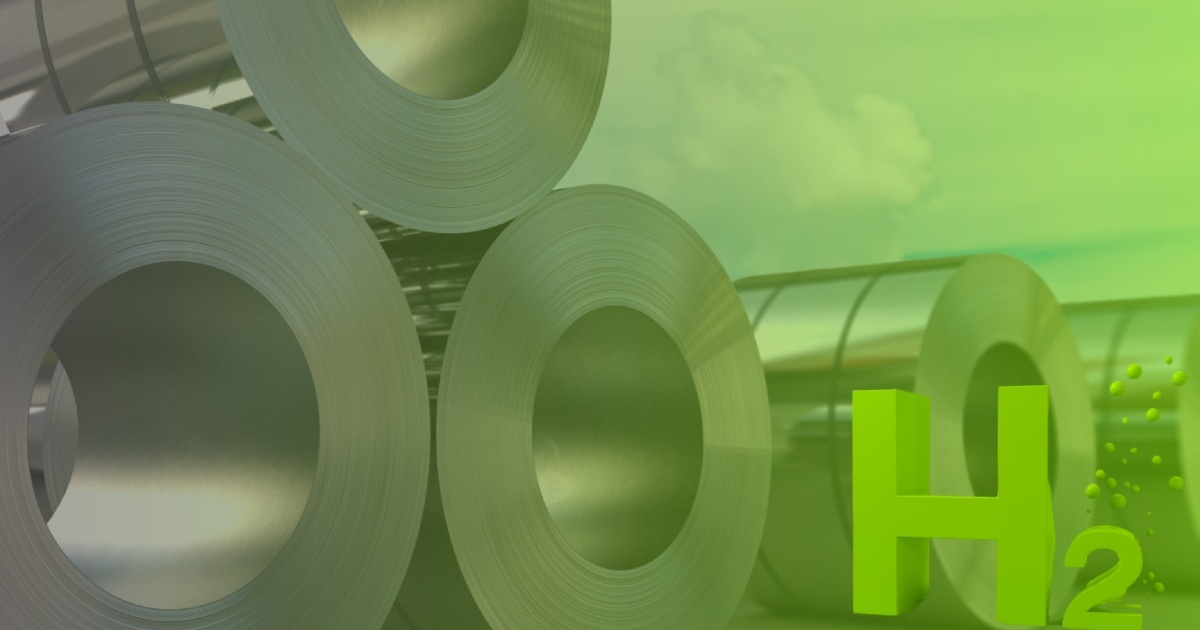Defossilizing Europe’s most energy-intensive industries is not only a climate imperative: it is a strategic and economic challenge. Among these industries, the steel sector holds a unique and complex position as the backbone of industrial infrastructure, providing essential materials for construction, transport, and manufacturing. Yet, it is also one of the largest emitters of greenhouse gases (GHGs), responsible for approximately 6–8% of global CO₂ emissions.
In its current form, steel production is heavily dependent on fossil fuels, especially coal and natural gas. These are used both as energy sources and as chemical reductants in processes like the blast furnace route and direct reduced iron (DRI) production. Decarbonising steel, therefore, means rethinking not just the energy supply but the foundations of the process itself.
Green hydrogen, which is hydrogen produced through water electrolysis powered by renewable electricity, has emerged as a leading contender to replace fossil-based inputs in steelmaking, especially when used as a reductant in place of coal or natural gas industrial furnaces, as it offers the promise of near-zero carbon steel. However, despite its theoretical potential, scaling green hydrogen solutions in heavy industry remains far from straightforward.
The barriers to green hydrogen adoption
While the technological foundations for using hydrogen in steel production are already known, the commercial and systemic barriers are significant. Today, most hydrogen used in steel industry is “grey hydrogen,” derived from natural gas through steam methane reforming (SMR), which is a process that emits large quantities of CO₂.
Replacing this with green hydrogen has been slower than hoped, for several reasons:
- High production costs: Electrolysis is still an expensive process. It requires large amounts of electricity that struggles to compete with fossil-derived alternatives.
- Infrastructure gaps: Hydrogen is a lightweight, highly flammable gas. Its transport, storage, and use require dedicated infrastructure that is not yet in place in many industrial regions.
- Investment risks: Retrofitting existing steel plants to use hydrogen—especially in the DRI route—requires substantial capital investment and carries operational uncertainties. In the absence of clear price signals or regulatory mandates, many producers hesitate to make the leap.
- Market uncertainty: Despite increasing demand for low-carbon products, the market for “green steel” is still developing. This limits the willingness of companies to pay a premium price, reducing the incentive to adopt greener inputs.
In short, making green hydrogen viable in the steel sector means addressing economic, infrastructural, and policy dimensions simultaneously.
H2STEEL: a circular and cost-effective alternative
This is the challenge that the European H2STEEL project - of which I3P is among the main partners - aims to overcome. Rather than relying on electricity-intensive electrolysis, H2STEEL introduces an innovative and potentially disruptive route to produce green hydrogen: catalytic pyrolysis of biomethane, using a waste-derived catalyst made from biochar, and exploiting residual heat at the steel plant.
At the heart of the H2STEEL concept is the idea of turning biowaste, such as sewage sludge and industrial waste, into valuable resources through an integrated circular economy model. Using an innovative reactor system and a biochar-based catalyst produced from digestate (a by-product of anaerobic digestion), the project enables the conversion of biomethane into two key outputs:
- Green hydrogen – a clean fuel that can replace fossil-based streams in steelmaking.
- Biocoal – a solid carbon material that can substitute fossil coal, reducing reliance on imported coal and cutting emissions.
In addition to these main products, the H2STEEL process also enables the recovery of critical raw materials (CRMs) from the biowaste, such as phosphorus and potassium. These elements can be reintegrated into agricultural supply chains as fertilisers, reducing the need for virgin resource extraction.
Economic and environmental impact
One of H2STEEL’s most compelling advantages is its cost competitiveness. By avoiding the need for high-purity water and expensive electricity, using negative-cost biowaste as feedstock, and recovering CRMs like phosphorous, the project significantly lowers the barrier to producing hydrogen at industrial scale. This makes it more accessible for steelmakers who might otherwise be deterred by the capital intensity of electrolysis-based solutions.
Moreover, the use of biocoal as a process by-product offers additional benefits. It replaces fossil coal in steelmaking, contributes to CO₂ emission reductions, and unlocks access to carbon credits under EU Emissions Trading System (ETS) regulations. In doing so, the H2STEEL process aims to further lower the overall cost of green hydrogen production for industrial applications, while also creating an additional business opportunity for companies involved.
This multi-output approach creates multiple streams of value:
- Green hydrogen and biocoal, as clean energy and chemical reductants;
- Recovered CRMs for fertiliser production;
- Environmental compliance advantages (carbon credits).
By generating economic value from waste, H2STEEL not only enhances resource efficiency but also aligns perfectly with EU goals for industrial symbiosis and circular value chains. By connecting waste management, renewable hydrogen production, and green steelmaking, the project establishes a new industrial ecosystem where each output feeds into the next link in the value chain.
This synergic system holds the potential to decarbonize key industrial sectors, create new market opportunities for biowaste utilization and reduce Europe’s dependence on fossil fuels and raw material imports.
Looking ahead
Green hydrogen can reshape the future of steel, but only if we rethink how it is produced, distributed, and integrated. European projects like H2STEEL show that there is more than one path to decarbonization, and that circular thinking can accelerate the journey.
As H2STEEL moves forward with its testing and validation phases, it offers a glimpse into how Europe can lead the clean industrial revolution by turning today’s waste into tomorrow’s competitive advantage.

